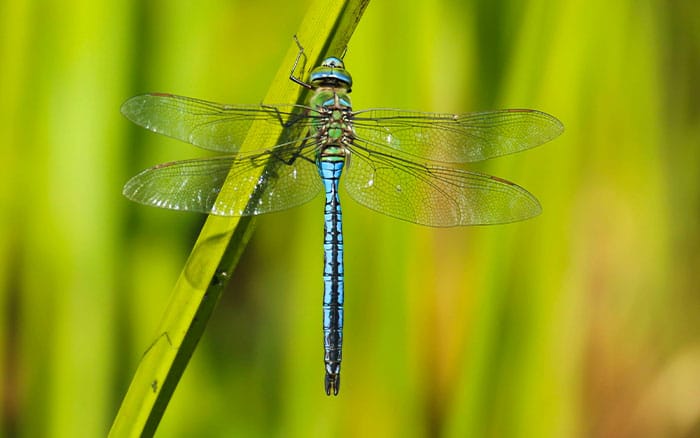Odonata is the name of the order that includes dragonflies and damsel flies. Odonata comes from the Ancient Greek terms which mean ‘toothed one’. So here’s a guide to dragonflies and damselflies that you may spot in or around your garden.
Dragonflies were one of the first winged insects to evolve. This happened around 300 million years ago. Back then, there were even dragonflies the side of eagles. Today there are about 5,500 different species across the world, and about 57 species of dragonflies documented in the UK.
What are dragonflies?
Dragonflies have a really unique appearance. One of the most recognisable things about them is that they have two massive eyes that are made up of 30,000 individual segments. Their eyes look upwards and are so large that they take up the space of most of their head.
Of course, there are also the wide wings that look intricately veined. These wings stay held outwards when the dragonfly is resting. These wings make the creature able to fly up, down, backwards and hover, as well as turning round incredibly quickly. In fact, they can even mate whilst in mid-air and also catch their prey whilst flying.
Dragonflies are carnivorous, eating insects like flies, midges, and mosquitos. They also eat butterflies, moths, and sometimes even smaller dragonflies. They catch their prey whilst flying, using the long legs to carry it. Then it carries it to a safe spot where it can tuck in.
Dragonflies and damselflies tend to favour wetland habitats, which is why they are commonly seen around ponds and lakes. They can most commonly be spotted during early to late summer.

Differences between dragonflies and damselflies
Dragonflies and damselflies are part of the same family, but there are a few key differences between the two.
- Damselflies are usually smaller and less robust than dragonflies
- Unlike dragonflies, damselflies close their wings whilst they’re resting
- Dragonflies have eyes that touch at the top of the head, but damselflies eyes aren’t at the top of the head
- Dragonflies have strong, agile flight compared to the weaker, fluttering flight of damselflies and they don’t combat aerially

Dragon lifecycle
Within the dragon lifecycle, there are three stages: egg, nymph, and adult.
The female dragonflies can lay hundreds of eggs in batches. They do this over days or weeks. Whilst the egg laying process is going on, the males guard the female by linking with them or keeping close by.
Once the eggs are laid, they generally hatch between 2-5 weeks after. The prolarva emerges from the egg, which looks like a tiny tadpole. These little larvae need to moult, and the timing will depend on where they were laid. If they were laid underwater, they will moult straight away. But ones that were laid above water will moult within a few hours. This shedding means they can rapidly grow. During the larva stage, they eat a lot to help them to grow into adulthood. This stage of the lifecycle depends on the species, but it can take either months or years.
Once the transition from nymph to adult is done, their focus is to find a mate. The adult stage only lasts a few months, so this becomes a top priority.
Types of dragonfly
Emperor dragonfly
First up is the largest species in Britain which can be commonly spotted around ponds and lakes, or sometimes canals and rivers between June and September.
They grow to a length of 78mm with bright abdomens. The males have blue abdomens, whilst the females have bright green colouration. They can also be identified by the way they fly because the rear of their abdomen is usually bent downwards.

Southern hawker
Next is Aeshna cyanea, which can be spotted near small ponds, so keep an eye out around garden ponds. Growing to 70mm in length, they have broad stripes on the thorax. Males are dark with bright blue and green markings, whist females are brown with green markings.
These can be spotted from June to October.

Four-spotted chaser
The four-spotted chaser can be spotted by its uniform brown colour, with two dots on each wing – hence the name! Both males and females of this species look alike.
With a typical length of 39-48mm, they are a medium sized dragonfly. Found in a variety of habitats, they can be seen around ponds, lakes, woods, heathland, and moorland too.

Common darter
This is the most common darter species and can be seen from June all the way into November. They grow up to 38-43mm, with slightly different colouring between males and females. Females begin adulthood bright in colour, going duller with time. Males are bright orange with yellow panels on the side.


Leave A Comment